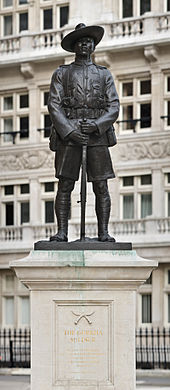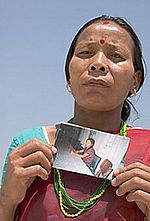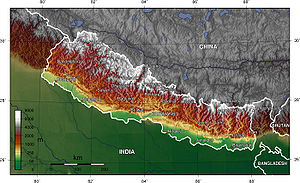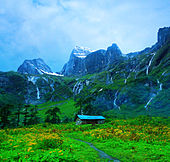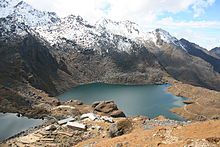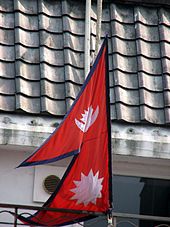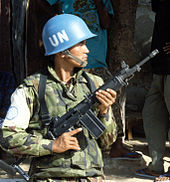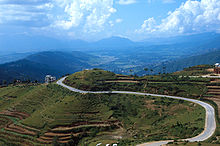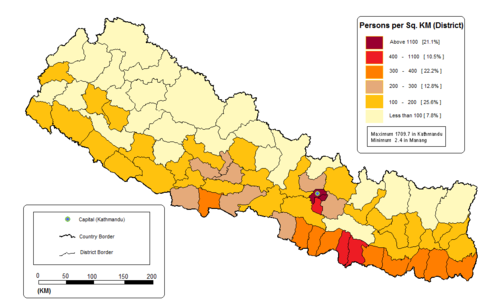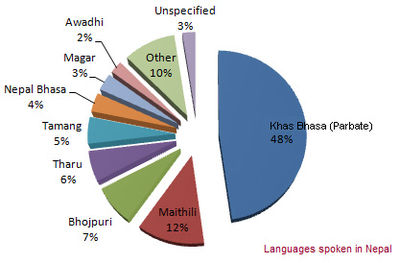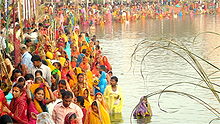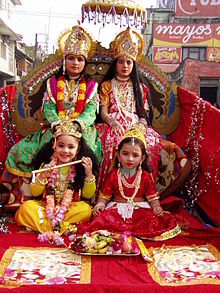- Nepal
-
Federal Democratic Republic of Nepal
सङ्घीय लोकतान्त्रिक गणतन्त्र नेपाल
Sanghiya Loktāntrik Ganatantra Nepāl

Flag Emblem Motto: जननी जन्मभूमिश्च स्वर्गादपि गरीयसी (Devanāgarī)
"Mother and Motherland are Greater than Heaven"Anthem: "Sayaun Thunga Phool Ka" Capital
(and largest city)Kathmandu
(Nepali: काठमाडौं)
27°42′N 85°19′E / 27.7°N 85.317°EOfficial language(s) Nepali[1] Recognised regional languages Nepal Bhasa, Maithili, Bhojpuri, Tharu, Gurung, Tamang, Magar, Awadhi, Sherpa, Kiranti, Limbu and other 100 different indigenous languages. Demonym Nepali Government Federal republic - President Ram Baran Yadav - Prime Minister Baburam Bhattarai (Maoist) Unification - Kingdom declared 21 December 1768 - State declared 15 January 2007 - Republic declared 28 May 2008 Area - Total 147,181 km2 (94th)
56,827 sq mi- Water (%) 2.8 Population - 2010 estimate 29,331,000[2] (40th) - 2011 census 26,620,000 - Density 199.3/km2 (62nd)
518.1/sq miGDP (PPP) 2010 estimate - Total $9500.813 billion[3] - Per capita $1,270[3] GDP (nominal) 2010 estimate - Total $15.836 billion[3] - Per capita $562[3] Gini (2003–04) 47.2 (high) HDI (2007)  0.553[4] (medium) (144th)
0.553[4] (medium) (144th)Currency Nepalese rupee ( NPR)Time zone NPT (UTC+5:45) - Summer (DST) not observed (UTC+5:45) Drives on the left ISO 3166 code NP Internet TLD .np Calling code +977 Nepal (नेपाल) (
 i/nɛˈpɔːl/ ne-pawl[5] Nepali: नेपाल [neˈpal] (
i/nɛˈpɔːl/ ne-pawl[5] Nepali: नेपाल [neˈpal] ( listen)), officially the Federal Democratic Republic of Nepal, is a landlocked sovereign state located in South Asia. It is located in the Himalayas and bordered to the north by the People's Republic of China, and to the south, east, and west by the Republic of India. With an area of 147,181 square kilometres (56,827 sq mi) and a population of approximately 30 million, Nepal is the world's 93rd largest country by land mass[6] and the 41st most populous country. Kathmandu is the nation's capital and the country's largest metropolis.
listen)), officially the Federal Democratic Republic of Nepal, is a landlocked sovereign state located in South Asia. It is located in the Himalayas and bordered to the north by the People's Republic of China, and to the south, east, and west by the Republic of India. With an area of 147,181 square kilometres (56,827 sq mi) and a population of approximately 30 million, Nepal is the world's 93rd largest country by land mass[6] and the 41st most populous country. Kathmandu is the nation's capital and the country's largest metropolis.Nepal has a rich geography. The mountainous north has eight of the world's ten tallest mountains, including the highest point on Earth, Mount Everest, called Sagarmatha in Nepali. It contains more than 240 peaks over 20,000 ft (6,096 m) above sea level.[7] The fertile and humid south is heavily urbanized.
By some measures, Hinduism is practised by a larger majority of people in Nepal than in any other nation.[8] Buddhism, though a minority faith in the country, is linked historically with Nepal. Many Nepali do not distinguish between Hinduism and Buddhism and follow both religious traditions. There are three different buddhist traditions: Himalayan Buddhism, Buddhism of Kathmandu Valley (mostly Mahayana and Vajrayana), and also the Theravada Buddhism.
A monarchy throughout most of its history, Nepal was ruled by the Shah dynasty of kings from 1768, when Prithvi Narayan Shah unified its many small kingdoms. However, a decade-long Civil War by the Communist Party of Nepal (Maoist) and several weeks of mass protests by all major political parties led to the 12 point agreement of November 22, 2005. The ensuing elections for the constituent assembly on May 28, 2008 overwhelmingly favored the abdication of the Nepali monarch Gyanendra Shah and the establishment of a federal multiparty representative democratic republic.[9] The first President of Nepal, Ram Baran Yadav, was sworn in on July 23, 2008.
Contents
Etymology
Nepal Bhasa origin
The word "Nepal" is believed by scholars to be derived from the word "Nepa:" which refers to the Newar Kingdom, the present day Kathmandu Valley. In early Sanskrit sources (Atharvaveda Parisista) and in Gupta period inscriptions, the country is referred to as Nepala. The Newars of present day Nepal, the inhabitants of the Kathmandu Valley and its peripheries, were referred as "Nepa:" before the advent of Shah dynasty.
Ne Muni
Local legends say that a Hindu sage named "Ne" established himself in the valley of Kathmandu in prehistoric times and that the word "Nepal" came into existence as the place protected ("pala" in Sanskrit) by the sage "Ne". This folk etymology of the name Nepal means, "the country looked after by Ne".[10]
He is said to have performed religious ceremonies at Teku, at the confluence of the Bagmati and Bishnumati rivers.[11] and to have selected a pious cowherd to be the first of the many kings of the Gopala Dynasty.[10] These rulers are said to have ruled Nepal for over 500 years.[12] He selected Bhuktaman to be the first king in the line of the Gopala (Cowherd) Dynasty.[11] The Gopala dynasty is said to have ruled for 621 years. Yakshya Gupta was the last king of this dynasty.
However, according to the Skanda Purana, a rishi called "Ne" or "Nemuni" used to live in Himalaya.[13] In the Pashupati Purana, he is mentioned as a saint and a protector.[14] He is said to have practised meditation at the Bagmati and Kesavati rivers[15] and to have taught there.[10]
History
It appears that Kirata people were one of the first to settle in Nepal; they are said to have ruled Nepal for about 2,500 years.[16]
Ancient
Nepal is first mentioned in the late Vedic text, Atharvaveda Parisista as a place exporting blankets, and in the post-Vedic Atharva Siras Upanisad.[17] In Samudragupta's Allahabad inscription it is mentioned as a bordering country. The 'Skanda Purana' has a separate chapter known as 'Nepal Mahatmya', which "explains in more details about the beauty and power of Nepal."[18] Nepal is also mentioned in Hindu texts such as the Narayana Puja.[17]
Around 500 BCE, small kingdoms and confederations of clans arose in the southern regions of Nepal. From one of these, the Shakya polity, arose a prince named Siddharta Gautama (traditionally dated 563–483 BCE), who later renounced his status to lead an ascetic life and came to be known as the Buddha ("the enlightened one"). It is believed that the 7th Kirata king, Jitedasti, was on the throne in the Nepal valley at the time. By 250 BCE, the southern regions came under the influence of the Mauryan Empire of northern India, and Nepal later on became a nominal vassal state under the Gupta Empire in the fourth century CE. Beginning in the 3rd century CE, rulers called the Licchavis governed the Kathmandu Valley and surrounding central Nepal.
There is a good and quite detailed description of the kingdom of Nepal in the account of the renowned Chinese Buddhist pilgrim monk Xuanzang, dating from c. 645 CE.[19][20]
The Licchavi dynasty went into decline in the late eighth century, probably due to Tibetan dominance, and was followed by a Newari or Thakuri era, from 879 CE (Nepal Samvat 1), although the extent of their control over the country is uncertain. In the 11th century it seems to have included the Pokhara area.
Medieval
In the early 12th century, leaders emerged in far western Nepal whose names ended with the Sanskrit suffix malla ("wrestler"). These kings consolidated their power and ruled over the next 200 years, until the kingdom splintered into two dozen petty states. Another Malla dynasty, beginning with Jayasthiti, emerged in the Kathmandu valley in the late 14th century, and much of central Nepal again came under a unified rule. However, in 1482 the realm was divided into three kingdoms: Kathmandu, Patan, and Bhaktapur.
Kingdom of Nepal
After centuries of petty rivalry between the three kingdoms, in the mid-18th century, Prithvi Narayan Shah, a Gorkha King, set out to unify the kingdoms. Seeking arms and aid from India, and buying the neutrality of bordering Indian kingdoms, he embarked on his mission in 1765. After several bloody battles and sieges, he managed to unify the Kathmandu Valley and surrounding territory three years later in 1768. However, an actual battle never took place to conquer the Kathmandu valley; it was taken over by Prithvi Narayan and his troops without any effort, during Indra Jatra, a festival of Newars, when all the valley's citizens were celebrating the festival. This event marked the birth of the modern nation of Nepal.
In 1788 the Nepalese overran Sikkim and sent a punitive raid into Tibet. Kangra in northern India was also occupied by the Nepalese. In 1809, Ranjit Singh the ruler of the Sikh state in the Punjab, had intervened and drove the Nepalese army east of the Satluj river.[21]
At its maximum extent, Greater Nepal extended from the Tista River in the east, to Kangara, across the Sutlej River in the west as well as further south into the Terai plains and north of the Himalayas than at present. A dispute and subsequent war with Tibet over the control of mountain passes forced the Nepalese to retreat and pay heavy reparations to Tibet.
Rivalry between Nepal and the British East India Company over the annexation of minor states bordering Nepal eventually led to the Anglo-Nepalese War (1815–16). At first the British underestimated the Nepalese and were soundly defeated until committing more military resources than they had anticipated needing. They were greatly impressed by the valour and competence of their adversaries. Thus began the reputation of "Gurkhas" as fierce and ruthless soldiers. The war ended in the Treaty of Sugauli, under which Nepal ceded recently captured portions of Sikkim and lands in Terai as well as the right to recruit soldiers.
Factionalism inside the royal family had led to a period of instability. In 1846 a plot was discovered revealing that the reigning queen had planned to overthrow Jung Bahadur Rana, a fast-rising military leader. This led to the Kot Massacre; armed clashes between military personnel and administrators loyal to the queen led to the execution of several hundred princes and chieftains around the country. Jung Bahadur Rana emerged victorious and founded the Rana lineage.
The king was made a titular figure, and the post of Prime Minister was made powerful and hereditary. The Ranas were staunchly pro-British and assisted them during the Indian Sepoy Rebellion in 1857 (and later in both World Wars). Some parts of the Terai Region were given back to Nepal by the British as a friendly gesture, because of her military help to sustain British control in India during the Sepoy Rebellion. In 1923, the United Kingdom and Nepal formally signed an agreement of friendship, in which Nepal's independence was recognized by the UK.
Slavery was abolished in Nepal in 1924.[22] Nevertheless debt bondage even involving debtors' children has been a persistent social problem in the Terai.
In the late 1940s, newly emerging pro-democracy movements and political parties in Nepal were critical of the Rana autocracy. Meanwhile, with the invasion of Tibet by China in the 1950s, India sought to counterbalance the perceived military threat from its northern neighbour by taking pre-emptive steps to assert more influence in Nepal. India sponsored both King Tribhuvan (ruled 1911–55) as Nepal's new ruler in 1951 and a new government, mostly comprising the Nepali Congress Party, thus terminating Rana hegemony in the kingdom.
After years of power wrangling between the king and the government, King Mahendra (ruled 1955–72) scrapped the democratic experiment in 1959, and a "partyless" panchayat system was made to govern Nepal until 1989, when the "Jan Andolan" (People's Movement) forced King Birendra (ruled 1972–2001) to accept constitutional reforms and to establish a multiparty parliament that took seat in May 1991.[23] In 1991–92, Bhutan expelled roughly 100,000 Bhutanese citizens of Nepali descent, most of whom have been living in seven refugee camps in eastern Nepal ever since.[24]
In 1996, the Communist Party of Nepal (Maoist) started a bid to replace the royal parliamentary system with a people's socialist republic by violent means. This led to the long Nepal Civil War and more than 12,000 deaths. On 1 June 2001, there was a massacre in the royal palace. King Birendra, Queen Aiswarya, and seven other members of the royal family were killed. The perpetrator was Crown Prince Dipendra, who committed suicide (he died 3 days later) shortly thereafter. This outburst was alleged to have been Dipendra's response to his parents' refusal to accept his choice of wife. Nevertheless there are speculation and doubts among Nepalese citizens about who was responsible.
Following the carnage, Birendra's brother Gyanendra inherited the throne. On 1 February 2005, Gyanendra dismissed the entire government and assumed full executive powers to quash the violent Maoist movement,[23] but this initiative was unsuccessful because a stalemate had developed where the Maoists were firmly entrenched in large expanses of countryside yet could not dislodge the military from numerous towns and the largest cities. In September 2005, the Maoists declared a three-month unilateral ceasefire to negotiate.
In response to the 2006 democracy movement King Gyanendra agreed to relinquish sovereign power to the people. On 24 April 2006 the dissolved House of Representatives was reinstated. Using its newly acquired sovereign authority, on 18 May 2006 the House of Representatives unanimously voted to curtail the power of the king and declared Nepal a secular state, ending its time-honoured official status as a Hindu Kingdom. On 28 December 2007, a bill was passed in parliament to amend Article 159 of the constitution – replacing "Provisions regarding the King" by "Provisions of the Head of the State" – declaring Nepal a federal republic, and thereby abolishing the monarchy.[26] The bill came into force on 28 May 2008.[27]
Republic
The Communist Party of Nepal (Maoist) won the largest number of seats in the Constituent Assembly election held on 10 April 2008, and formed a coalition government which included most of the parties in the CA. Although acts of violence occurred during the pre-electoral period, election observers noted that the elections themselves were markedly peaceful and "well-carried out".[28]
The newly elected Assembly met in Kathmandu on 28 May 2008, and, after a polling of 564 constituent Assembly members, 560 voted to form a new government,[27][29] with the monarchist Rastriya Prajatantra Party, which had four members in the assembly, registering a dissenting note. At that point, it was declared that Nepal had become a secular and inclusive democratic republic,[30] with the government announcing a three-day public holiday from 28 to 30 May. The King was thereafter given 15 days to vacate the Narayanhiti Royal Palace, to re-open it as a public museum.
Nonetheless, political tensions and consequent power-sharing battles have continued in Nepal. In May 2009, the Maoist-led government was toppled and another coalition government with all major political parties barring the Maoists was formed. Madhav Kumar Nepal of the Communist Party of Nepal (Unified Marxist-Leninist) was made the Prime Minister of the coalition government.
Geography
Nepal is of roughly trapezoidal shape, 800 kilometres (497 mi) long and 200 kilometres (124 mi) wide, with an area of 147,181 km2 (56,827 sq mi). See List of territories by size for the comparative size of Nepal. It lies between latitudes 26° and 31°N, and longitudes 80° and 89°E.
Nepal is commonly divided into three physiographic areas: Mountain, Hill and Terai. These ecological belts run east-west and are vertically intersected by Nepal's major, north to south flowing river systems.
The southern lowland plains or Terai bordering India are part of the northern rim of the Indo-Gangetic plains. They were formed and are fed by three major Himalayan rivers: the Kosi, the Narayani, and the Karnali as well as smaller rivers rising below the permanent snowline. This region has a subtropical to tropical climate. The outermost range of foothills called Shiwalik or Churia Range cresting at 700 to 1,000 metres (2,297 to 3,281 ft) marks the limit of the Gangetic Plain, however broad, low valleys called Inner Tarai (Bhitri Tarai Uptyaka) lie north of these foothills in several places.
The Hill Region (Pahad) abuts the mountains and varies from 800 to 4,000 metres (2,625 to 13,123 ft) in altitude with progression from subtropical climates below 1,200 metres (3,937 ft) to alpine climates above 3,600 metres (11,811 ft). The Mahabharat Range reaching 1,500 to 3,000 metres (4,921 to 9,843 ft) is the southern limit of this region, with subtropical river valleys and "hills" alternating to the north of this range. Population density is high in valleys but notably less above 2,000 metres (6,562 ft) and very low above 2,500 metres (8,202 ft) where snow occasionally falls in winter.
The Mountain Region (Parbat), situated in the Great Himalayan Range, makes up the northern part of Nepal. It contains the highest elevations in the world including 8,848 metres (29,029 ft) height Mount Everest (Sagarmatha in Nepali) on the border with China. Seven other of the world's eight thousand metre peaks are in Nepal or on its border with China: Lhotse, Makalu, Cho Oyu, Kanchenjunga, Dhaulagiri, Annapurna and Manaslu.
Nepal has five climatic zones, broadly corresponding to the altitudes. The tropical and subtropical zones lie below 1,200 metres (3,937 ft), the temperate zone 1,200 to 2,400 metres (3,937 to 7,874 ft), the cold zone 2,400 to 3,600 metres (7,874 to 11,811 ft), the subarctic zone 3,600 to 4,400 metres (11,811 to 14,436 ft), and the Arctic zone above 4,400 metres (14,436 ft).
Nepal experiences five seasons: summer, monsoon, autumn, winter and spring. The Himalaya blocks cold winds from Central Asia in the winter and forms the northern limit of the monsoon wind patterns. In a land once thickly forested, deforestation is a major problem in all regions, with resulting erosion and degradation of ecosystems.
Nepal is popular for mountaineering, containing some of the highest and most challenging mountains in the world, including Mount Everest. Technically, the south-east ridge on the Nepali side of the mountain is easier to climb; so, most climbers prefer to trek to Everest through Nepal.
Neotectonics
The collision between the Indian subcontinent and the Eurasian continent, which started in Paleogene time and continues today, produced the Himalaya and the Tibetan Plateau, a spectacular modern example of the effects of plate tectonics. Nepal lies completely within this collision zone, occupying the central sector of the Himalayan arc, nearly one third of the 2,400 km (1,500 mi)-long Himalayas.[31][32][33][34][35][36]
The Indian plate continues to move north relative to Asia at the rate of approximately 50 mm (2.0 in) per year.[37] Given the great magnitudes of the blocks of the Earth's crust involved, this is remarkably fast, about twice the speed at which human fingernails grow. As the strong Indian continental crust subducts beneath the relatively weak Tibetan crust, it pushes up the Himalayan mountains. This collision zone has accommodated huge amounts of crustal shortening as the rock sequences slide one over another.
Erosion of the Himalayas is a very important source of sediment, which flows via several great rivers (the Indus to the Indian Ocean, and the Ganges and Brahmaputra river system) to the Bay of Bengal.[38]
Environment
The dramatic differences in elevation found in Nepal result in a variety of biomes, from tropical savannas along the Indian border, to subtropical broadleaf and coniferous forests in the Hill Region, to temperate broadleaf and coniferous forests on the slopes of the Himalaya, to montane grasslands and shrublands and rock and ice at the highest elevations.
At the lowest elevations is the Terai-Duar savanna and grasslands ecoregion. These form a mosaic with the Himalayan subtropical broadleaf forests, which occur from 500 to 1,000 metres (1,600 to 3,300 ft) and include the Inner Terai Valleys. Himalayan subtropical pine forests occur between 1,000 and 2,000 metres (3,300 and 6,600 ft).
Above these elevations, the biogeography of Nepal is generally divided from east to west by the Gandaki River. Ecoregions to the east tend to receive more precipitation and to be more species-rich. Those to the west are drier with fewer species.
From 1,500 to 3,000 metres (4,900 to 9,800 ft), are temperate broadleaf forests: the eastern and western Himalayan broadleaf forests. From 3,000 to 4,000 metres (9,800 to 13,000 ft) are the eastern and western Himalayan subalpine conifer forests. To 5,500 metres (18,000 ft) are the eastern and western Himalayan alpine shrub and meadows.
Subdivisions
Nepal is divided into 14 zones and 75 districts, grouped into five development regions. Each district is headed by a permanent chief district officer responsible for maintaining law and order and coordinating the work of field agencies of the various government ministries. The five regions and 14 zones are:
- Eastern Region (Purwanchal)
- Koshi
- Mechi
- Sagarmatha
- Central Region (Madhyamanchal)
- Western Region (Pashchimanchal)
- Mid-Western Region (Madhya Pashchimanchal)
- Far-Western Region (Sudur Pashchimanchal)
Government and politics
Nepal has seen rapid political changes during the last two decades. Uptil 1990, Nepal was a monarchy running under the executive control of the king. Faced with a Communist movement against the absolute monarchy, King Birendra, in 1990, agreed to large-scale political reforms by creating a parliamentary monarchy with the king as the head of state and a prime minister as the head of the government. Nepal has also been noted for its recent speed of development, such as being one of the few countries in Asia to abolish the death penalty[39] and the first country in Asia to rule in favor of same-sex marriage, which the government has a seven-person committee studying after a November 2008 ruling by the nation's Supreme Court, which ordered full rights for LGBT individuals, including the right to marry.[40]
Nepal's legislature was bicameral, consisting of a House of Representatives called the Pratinidhi Sabha and a National Council called the Rastriya Sabha. The House of Representatives consisted of 205 members directly elected by the people. The National Council had 60 members: ten nominated by the king, 35 elected by the House of Representatives, and the remaining 15 elected by an electoral college made up of chairs of villages and towns. The legislature had a five-year term but was dissolvable by the king before its term could end. All Nepali citizens 18 years and older became eligible to vote.
The executive comprised the King and the Council of Ministers (the cabinet). The leader of the coalition or party securing the maximum seats in an election was appointed as the Prime Minister. The Cabinet was appointed by the king on the recommendation of the Prime Minister. Governments in Nepal tended to be highly unstable, falling either through internal collapse or parliamentary dissolution by the monarch, on the recommendation of the prime minister, according to the constitution; no government has survived for more than two years since 1991.
The movement in April 2006 brought about a change in the nation's governance: an interim constitution was promulgated, with the King giving up power, and an interim House of Representatives was formed with Maoist members after the new government held peace talks with the Maoist rebels. The number of parliamentary seats was also increased to 330. In April 2007, the Communist Party of Nepal (Maoist) joined the interim government of Nepal.
In December 2007, the interim parliament passed a bill making Nepal a federal republic, with a president as head of state. Elections for the constitutional assembly were held on 10 April 2008; the Maoist party led the results but did not achieve a simple majority of seats.[41] The new parliament adopted the 2007 bill at its first meeting by an overwhelming majority, and King Gyanendra was given 15 days to leave the Royal Palace in central Kathmandu. He left on 11 June.[42]
On 26 June, the prime minister Girija Prasad Koirala, who had served as Acting Head of State since January 2007, announced that he would resign on the election of the country's first president by the Constituent Assembly. The first round of voting, on 19 July, saw Parmanand Jha win election as Nepali vice-president, but neither of the contenders for president received the required 298 votes and a second round was held two days later. Ram Baran Yadav of the Nepali Congress party defeated Maoist-backed Ram Raja Prasad Singh with 308 of the 590 votes cast.[43] Koirala submitted his resignation to the new president after Yadav's swearing-in ceremony on 23 July.
On 15 August 2008, Maoist leader Prachanda (Pushpa Kamal Dahal) was elected Prime Minister of Nepal, the first since the country's transition from a monarchy to a republic. On 4 May 2009, Dahal resigned over on-going conflicts over sacking of the Army chief. Since Dahal's resignation, the country has been in a serious political deadlock – one of the big issues being the proposed integration of the former Maoist combatants, also known as the People's Liberation Army, into the national security forces.[44] After Dahal, Jhala Nath Khanal of CPN (UML) became Prime Minister. As Khanal could not succeeded to facilitate to make new constitution,in August 2011, Maoist Dr. Babu Ram Bhattarai became third Prime Minister after the election of contituent assembly.
Military and foreign affairs
Nepal's military consists of the Nepalese Army, which includes the Nepalese Army Air Service (the air force unit under it.) Nepalese Police Force is the civilian police and the Armed Police Force Nepal[45] is the paramilitary force. Service is voluntary and the minimum age for enlistment is 18 years. Nepal spends $99.2 million (2004) on its military—1.5% of its GDP. Much of the equipment and arms are imported from India. Consequently, the US provided M16s M4s and other Colt weapons to combat communist (Maoist) insurgents. As of now, the standard-issue battle rifle of the Nepalese army is the Colt M16.[46]
Nepal has close ties with both of its neighbours, India and China. In accordance with a long-standing treaty, Indian and Nepalese citizens may travel to each others' countries without a passport or visa. Nepalese citizens may work in India without legal restriction. However, since the Government of Nepal has been dominated by Socialists and India's by more right-wing parties, India has been remilitarizing the "porous" Indo-Nepali border, in order to stifle the flow of Islamist groups.[47] Nepal established relations with the People's Republic of China on August 1, 1955, and relations since have been based on the Five Principles of Peaceful Coexistence. Nepal has aided China in the aftermath of the 2008 Sichuan earthquake, and China has provided economic assistance for Nepali infrastructure. Both countries have cooperated to host the 2008 Summer Olympics summit of Mt. Everest.[48] Nepal has assisted in curbing anti-China protests from the Tibetan diaspora.[49]
Economy
 A Rs.500 banknote of The Republic of Nepal. For economic reasons, the watermark on the right still contains a picture of King Gyanendra, obscured by printing a rhododendron, the national flower of Nepal.[50]
A Rs.500 banknote of The Republic of Nepal. For economic reasons, the watermark on the right still contains a picture of King Gyanendra, obscured by printing a rhododendron, the national flower of Nepal.[50]
Nepal's gross domestic product (GDP) for 2008 was estimated at over $12 billion (adjusted to Nominal GDP), making it the 115th-largest economy in the world. Agriculture accounts for about 40% of Nepal's GDP, services comprise 41% and industry 22%. Agriculture employs 76% of the workforce, services 18% and manufacturing/craft-based industry 6%. Agricultural produce – mostly grown in the Terai region bordering India – includes tea, rice, corn, wheat, sugarcane, root crops, milk, and water buffalo meat. Industry mainly involves the processing of agricultural produce, including jute, sugarcane, tobacco, and grain.
Its workforce of about 10 million suffers from a severe shortage of skilled labour. About 25% of the population live below the international poverty line of $1.25 a day.[51]. This is a significant improvement from the 41.2% in 1995-96. The spectacular landscape and diverse, exotic cultures of Nepal represent considerable potential for tourism, but growth in this hospitality industry has been stifled by recent political events. In 2009, the number of international tourists visiting Nepal was 509,956. The rate of unemployment and underemployment approaches half of the working-age population. Thus many Nepali citizens move to India in search of work; the Gulf countries and Malaysia being new sources of work. Nepal receives $50 million a year through the Gurkha soldiers who serve in the Indian and British armies and are highly esteemed for their skill and bravery. The total remittance value is worth around $1 billion, including money sent from the Persian Gulf and Malaysia, who combined employ around 700,000 Nepali citizens.
A long-standing economic agreement underpins a close relationship with India. The country receives foreign aid from India, Japan, the UK, the US, the EU, China, Switzerland, and Scandinavian countries. Poverty is acute; per-capita income is around $1,000.[52] The distribution of wealth among the Nepalis is consistent with that in many developed and developing countries: the highest 10% of households control 39.1% of the national wealth and the lowest 10% control only 2.6%.
The government's budget is about $1.153 billion, with expenditure of $1.789 billion (FY05/06). The Nepalese rupee has been tied to the Indian Rupee at an exchange rate of 1.6 for many years. Since the loosening of exchange rate controls in the early 1990s, the black market for foreign exchange has all but disappeared. The inflation rate has dropped to 2.9% after a period of higher inflation during the 1990s.
Nepal's exports of mainly carpets, clothing, leather goods, jute goods and grain total $822 million. Import commodities of mainly gold, machinery and equipment, petroleum products and fertilizer total US$2 bn. India (53.7%), the US (17.4%), and Germany (7.1%) are its main export partners. Nepal's import partners include India (47.5%), the United Arab Emirates (11.2%), China (10.7%), Saudi Arabia (4.9%), and Singapore (4%).[53]
Nepal Tourism Year 2011
The country is currently celebrating Nepal Tourism Year 2011 after an official launch by the nation's President, Dr Ram Baran Yadav, at the Dasarath stadium in the capital amidst a grand celebration on 14 January 2011.
Infrastructure
Nepal remains isolated from the world's major land, air and sea transport routes although, within the country, aviation is in a better state, with 48 airports, ten of them with paved runways; flights are frequent and support a sizable traffic. The hilly and mountainous terrain in the northern two-thirds of the country has made the building of roads and other infrastructure difficult and expensive. There were just over 8,500 km (5,282 mi) of paved roads, and one 59-km railway line in the south in 2003. There is only one reliable road route from India to the Kathmandu Valley.
The only practical seaport of entry for goods bound for Kathmandu is Calcutta in India. Internally, the poor state of development of the road system (22 of 75 administrative districts lack road links) makes volume distribution unrealistic. Besides having landlocked, rugged geography, few tangible natural resources and poor infrastructure, the long-running civil war is also a factor in stunting the economic growth.[54]
There is less than one telephone per 19 people. Landline telephone services are not adequate nationwide but are concentrated in cities and district headquarters. Mobile telephony is in a reasonable state in most parts of the country with increased accessibility and affordability; there were around 175,000 Internet connections in 2005. After the imposition of the "state of emergency", intermittent losses of service-signals were reported, but uninterrupted Internet connections have resumed after Nepal's second major people's revolution to overthrow the King's absolute power.[53]
Demographics
Nepal's population has grown from 9 million people in 1950 to 26.6 million in 2011.[55]
The Nepalese are descendants of three major migrations from India, Tibet, and North Burma and Yunnan via Assam. Even though Indo-Nepalese migrants were latecomers to Nepal relative to the migrants from the north, they have come to dominate the country not only numerically, but also socially, politically, and economically.[56]
Among the earliest inhabitants were the Kirat of east mid-region, Newar of the Kathmandu Valley and aboriginal Tharu in the southern Terai region. The ancestors of the Brahmin and Chetri caste groups came from India's present Kumaon, Garhwal and Kashmir regions, while other ethnic groups trace their origins to North Burma and Yunnan and Tibet, e.g. the Gurung and Magar in the west, Rai and Limbu in the east (from Yunnan and north Burma via Assam), and Sherpa and Bhutia in the north (from Tibet).
In the Terai, a part of the Ganges Basin with 20% of the land, much of the population is physically and culturally similar to the Indo-Aryans of northern India. Indo-Aryan and East-Asian-looking mixed people live in the hill region. Indo-Aryan ancestry has been a source of prestige in Nepal for centuries, and the ruling families have been of Indo-Aryan and Hindu background.[57] The mountainous highlands are sparsely populated. Kathmandu Valley, in the middle hill region, constitutes a small fraction of the nation's area but is the most densely populated, with almost 5% of the population.
Nepal is a multilingual society.
These data are largely derived from Nepal's 2001 census results published in the Nepal Population Report 2002.
According to the World Refugee Survey 2008, published by the US Committee for Refugees and Immigrants, Nepal hosted a population of refugees and asylum seekers in 2007 numbering approximately 130,000. Of this population, approximately 109,200 persons were from Bhutan and 20,500 from People's Republic of China.[58][59] The government of Nepal restricted ethnic Nepalese expelled from Bhutan to seven camps in the Jhapa and Morang districts, and refugees were not permitted to work in most professions.[58] At present, the United States is working towards resettling more than 60,000 of these refugees in the US.[24]
Population Structure Data Size Population 28,676,547 (2005) Growth Rate 2.2% Population below 14 Years old 39% Population of age 15 to 64 57.3% Population above 65 3.7% The median age (Average) 20.07 The median age (Male) 19.91 The median age (Females) 20.24 Ratio (Male:Female) 1, 000:1,060 Life expectancy (Average) 59.8 Years Life expectancy (Male) 60.9 Life expectancy (Female) 59.5 Literacy Rate (Average) 53.74% Literacy Rate (Male) 68.51% Literacy Rate (Female) 42.49% Despite the migration of a significant section of the population to the southern plains or terai in recent years, the majority of the population still lives in the central highlands. The northern mountains are sparsely populated.
Kathmandu, with a population of around 800,000 (metropolitan area: 1.5 million), is the largest city in the country.
Languages
Nepal's diverse linguistic heritage evolved from four major language groups: Indo-Aryan, Tibeto-Burman, Mongolian and various indigenous language isolates. The major languages of Nepal (percent spoken as mother tongue) are Nepali (70%), Maithili (5%), Bhojpuri (3%), Tharu (4%), Tamang (3%), Newari/Nepal Bhasa (3.6%), Magar (2.4%), Rai (2.8%), Awadhi (2.5%), Limbu (1.5%), and Bajjika (1%).
Derived from Sanskrit, Nepali has roots in Sanskrit and is written in Devanagari script. Nepali is the official national language and serves as lingua franca among Nepalis of different ethnolinguistic groups. Regional dialects Awadhi, Bhojpuri, Maithili and rarely Hindi are spoken in the southern Terai Region. Many Nepalis in government and business speak English as well. Dialects of Tibetan are spoken in and north of the higher Himalaya where standard literary Tibetan is widely understood by those with religious education. Local dialects in the Terai and hills are mostly unwritten with efforts underway to develop systems for writing many in Devanagari or the Roman alphabet.
Religion
The overwhelming majority of the Nepalese population follows Hinduism. Shiva is regarded as the guardian deity of the country.[60] Nepal is home to the famous Lord Shiva temple, the Pashupatinath Temple, where Hindus from all over the world come for pilgrimage. According to mythology, Sita Devi of the epic Ramayana, was born in the Mithila Kingdom of King Janaka Raja.
Lumbini is a Buddhist pilgrimage site and UNESCO World Heritage Site site in the Kapilavastu district. Traditionally it is held to be the birthplace in about 563 B.C. of Siddhartha Gautama, a Kshatriya caste prince of the Sakya clan, who, as the Buddha Gautama, gave birth to the Buddhist tradition.
The holy site of Lumbini is bordered by a large monastic zone, in which only monasteries can be built. All three main branches of Buddhism exist in Nepal and the Newa people have their own branch of the faith. Buddhism is also the dominant religion of the thinly populated northern areas, which are mostly inhabited by Tibetan-related peoples, such as the Sherpa.
The Buddha, born as a Hindu, is also said to be a descendant of Vedic Sage Angirasa in many Buddhist texts.[61] The Buddha's family surname is associated with Gautama Maharishi.[62] Differences between Hindus and Buddhists have been minimal in Nepal due to the cultural and historical intermingling of Hindu and Buddhist beliefs. Morever traditionally Buddhism and Hinduism were never two distinct religions in the western sense of the word. In Nepal, the faiths share common temples and worship common deities. Among other natives of Nepal, those more influenced by Hinduism were the Magar, Sunwar, Limbu and Rai and the Gurkhas.[16] Hindu influence is less prominent among the Gurung, Bhutia, and Thakali groups who employ Buddhist monks for their religious ceremonies.[16][53] Most of the festivals in Nepal are Hindu.[63] The Machendrajatra festival, dedicated to Hindu Shaiva Siddha, is celebrated by many Buddhists in Nepal as a main festival.[64] As it is believed that Ne Muni established Nepal,[65] some important priests in Nepal are called "Tirthaguru Nemuni".
Islam is a minority religion in Nepal, with 4.2 % of the population being Muslim according to a 2006 Nepalese census.[66] Mundhum, Christianity and Jainism are other minority faiths.[67]
Education
About two thirds of female adults and one third of male adults are illiterate.[68] Net primary enrollment rate was 74% in 2005.[68] It is currently at about 90%.[69] In 2009 the World Bank has decided to contribute a further $130 million towards meeting Nepal's Education for All goals.[69] Nepal has several universities.
Largest cities
- The 10 largest cities (by population)[70]
- Kathmandu (Pop.: 989,273[71] [72])
- Pokhara (Pop.: 200,000)
- Patan (Pop.: 183,310)
- Biratnagar (Pop.: 182,324)
- Birgunj (Pop.: 133,238)
- Dharan Bazar (Pop.: 108,600)
- Bharatpur (Pop.: 107,157)
- Janakpur (Pop.: 93,767)
- Dhangadhi (Pop.: 92,294)
- Butwal (Pop.: 91,733)
Culture
A typical Nepalese meal is dal-bhat-tarkari. Dal is a spicy lentil soup, served over bhat (boiled rice), served with tarkari (curried vegetables) together with achar (pickles) or chutni (spicy condiment made from fresh ingredients). The Newar community, however, has its own unique cuisine. It consists of non-vegetarian as well as vegetarian items served with alcoholic and non-alcoholic beverages. Mustard oil is the cooking medium and a host of spices, such as cumin, coriander, black peppers, sesame seeds, turmeric, garlic, ginger, methi (fenugreek), bay leaves, cloves, cinnamon, pepper, chillies, mustard seeds, etc., are used in the cooking. The cuisine served on festivals is generally the best.
The Newari Music orchestra consists mainly of percussion instruments, though wind instruments, such as flutes and other similar instruments, are also used. String instruments are very rare. There are songs pertaining to particular seasons and festivals. Paahan chare music is probably the fastest played music whereas the Dapa the slowest. There are certain musical instruments such as Dhimay and Bhusya which are played as instrumental only and are not accompanied with songs. The dhimay music is the loudest one. In the hills, people enjoy their own kind of music, playing saarangi (a string instrument), madal and flute. They also have many popular folk songs known as lok geet and lok dohari.
The Newar dances can be broadly classified into masked dances and non-masked dances. The most representative of Newari dances is Lakhey dance. Almost all the settlements of Newaris organise Lakhey dance at least once a year, mostly in the Goonlaa month. So, they are called Goonlaa Lakhey. However, the most famous Lakhey dance is the Majipa Lakhey dance; it is performed by the Ranjitkars of Kathmandu and the celebration continues for the entire week that contains the full moon of Yenlaa month. The Lakhey are considered to be the saviors of children.
Folklore is an integral part of Nepalese society. Traditional stories are rooted in the reality of day-to-day life, tales of love, affection and battles as well as demons and ghosts and thus reflect local lifestyles, cultures and beliefs. Many Nepalese folktales are enacted through the medium of dance and music.
The Nepali year begins in mid-April and is divided into 12 months. Saturday is the official weekly holiday. Main annual holidays include the National Day, celebrated on the birthday of the king (28 December), Prithvi Jayanti (11 January), Martyr's Day (18 February), and a mix of Hindu and Buddhist festivals such as dashain in autumn, and tihar in late autumn. During tihar, the Newar community also celebrates its New Year as per their local calendar Nepal Sambat.
Most houses in rural lowland of Nepal are made up of a tight bamboo framework and walls of a mud and cow-dung mix. These dwellings remain cool in summer and retain warmth in winter. Houses in the hills are usually made of unbaked bricks with thatch or tile roofing. At high elevations construction changes to stone masonry and slate may be used on roofs.
Nepal's flag is the only national flag in the world that is not rectangular in shape.[73] According to its official description, the red in the flag stands for victory in war or courage, and is also color of the rhododendron, the national flower of Nepal. Red also stands for aggression. The flag's blue border signifies peace. The curved moon on the flag is a symbol of the peaceful and calm nature of Nepalese, while the sun represents the aggressiveness of Nepalese warriors.
See also
- Outline of Nepal
- Index of Nepal-related articles
Footnotes
- ^ According to Interim Constitution Nepali is only the official language (article 5, point 2). Other languages spoken as the mother tongue in Nepal are the national languages (article 5, point 1). According to article 5, point 3, all languages are accepted as official languages at the regional level. Today's more than 90% people speak Nepali as a 1st language. Nepal_Interim_Constitution2007
- ^ Department of Economic and Social Affairs Population Division (2009) (PDF). World Population Prospects, Table A.1. 2008 revision. United Nations. http://www.un.org/esa/population/publications/wpp2008/wpp2008_text_tables.pdf. Retrieved 12 March 2009.
- ^ a b c d "Nepal". International Monetary Fund. http://www.imf.org/external/pubs/ft/weo/2011/01/weodata/weorept.aspx?sy=2008&ey=2011&scsm=1&ssd=1&sort=country&ds=.&br=1&c=558&s=NGDPD%2CNGDPDPC%2CPPPGDP%2CPPPPC%2CLP&grp=0&a=&pr.x=28&pr.y=15. Retrieved 21 April 2011.
- ^ "Human Development Report 2009. Human development index trends: Table G". The United Nations. http://hdr.undp.org/en/media/HDR_2009_EN_Complete.pdf. Retrieved 5 October 2009.
- ^ "Nepal". Oxford English Dictionary. Oxford University Press. 2nd ed. 1989.
- ^ "The World Factbook : Rank order population". CIA. https://www.cia.gov/library/publications/the-world-factbook/rankorder/2147rank.html.
- ^ Shaha (1992), p. 1.
- ^ "CIA Factbook, Nepal, "People" section". Cia.gov. https://www.cia.gov/library/publications/the-world-factbook/geos/np.html#People. Retrieved 29 July 2009.
- ^ "Nepal's first president sworn in". Radio Australia. 24 July 2008. http://www.radioaustralia.net.au/news/stories/200807/s2312720.htm?tab=asia.[dead link]
- ^ a b c W.B., P. 34 Land of the Gurkhas
- ^ a b "The Ancient Period". Infoclub.com.np. http://www.infoclub.com.np/nepal/history/history_ancient.htm. Retrieved 29 July 2009.
- ^ Balfour, P. 195 Cyclopædia of India and of Eastern and Southern Asia, :
- ^ Dangol, Amrit (6 May 2007). "Alone In Kathmandu". Alone In Kathmandu. http://www.aloneinkathmandu.com/2007/05/something-about-nepal.html. Retrieved 29 July 2009.
- ^ Prasad, P. 4 The life and times of Maharaja Juddha Shumsher Jung Bahadur Rana of Nepal
- ^ Khatri, P. 16 The Postage Stamps of Nepal
- ^ a b c "A Country Study: Nepal". Federal Research Division, Library of Congress. http://memory.loc.gov/frd/cs/nptoc.html. Retrieved 23 September 2005.
- ^ a b P. 17 Looking to the Future: Indo-Nepal Relations in Perspective By Lok Raj Baral
- ^ Terai News
- ^ Li, Rongxi (translator). 1995. The Great Tang Dynasty Record of the Western Regions, pp. 219–220. Numata Center for Buddhist Translation and Research. Berkeley, California. ISBN 1-886439-02-8
- ^ Watters, Thomas. 1904-5. On Yuan Chwang's Travels in India (A.D. 629–645), pp. 83–85. Reprint: Mushiram Manoharlal Publishers, New Delhi. 1973.
- ^ "The Enclosing of Nepal". Countrystudies.us. Source: U.S. Library of Congress.
- ^ Tucci, Giuseppe. (1952). Journey to Mustang, 1952. Trans. by Diana Fussell. 1st Italian edition, 1953; 1st English edition, 1977. 2nd edition revised, 2003, p. 22. Bibliotheca Himalayica. ISBN 99933-0-378-X (South Asia); ISBN 974-524-024-9 (Outside of South Asia).
- ^ a b "Timeline: Nepal". BBC News. http://news.bbc.co.uk/1/hi/world/south_asia/country_profiles/1166516.stm. Retrieved 29 September 2005.
- ^ a b Bhaumik, Subir (7 November 2007). "Bhutan refugees are 'intimidated'". BBC News. http://news.bbc.co.uk/2/hi/south_asia/7082586.stm. Retrieved 25 April 2008.
- ^ "Combating Girl-Trafficking and Sex Slavery". Nepal Monitor. June 26, 2007
- ^ Nepal votes to abolish monarchy – CNN[dead link]
- ^ a b "Nepal votes to abolish monarchy". BBC News. 2008-05-28. http://news.bbc.co.uk/2/hi/south_asia/7424302.stm. Retrieved 2011-05-22.
- ^ The Carter Center. "Activities by Country: Nepal". http://www.cartercenter.org/countries/nepal.html. Retrieved 17 July 2008.
- ^ "Kantipuronline.com". Kantipuronline.com. http://www.kantipuronline.com/kolnews.php?nid=148454. Retrieved 2010-12-22.[dead link]
- ^ "Nepal abolishes its monarchy". Al Jazeera. 28 May 2008. http://english.aljazeera.net/NR/exeres/0A9B5B1F-5BF2-4ACB-A159-700F21DAD3C4.htm. Retrieved 29 May 2008.[dead link]
- ^ Beek van der Peter, Xavier Robert, Jean-Louis Mugnier, Matthias Bernet, Pascale Huyghe and Erika Labrin, "Late Miocene- Recent Exhumation of the Central Himalaya and Recycling in the Foreland Basin Assessed by Apatite Fission-Track Thermochronology of Siwalik Sediments, Nepal", Basic research, 18, 413–434, 2006.
- ^ Berger Antoine, Francois Jouanne, Riadm Hassani and Jean Louis Mugnier, "Modelling the Spatial Distribution of Present day Deformation in Nepal: how cylindrical is the Main Himalayan Thrust in Nepal?", Geophys.J.Int., 156, 94–114, 2004.
- ^ Bilham Roger and Michael Jackson,"Constraints on Himalayan Deformation inferred from Vertical Velocity Fields in Nepal and Tibet," Journal of Geophysical Research, vol. 99, 897–912, 10 July 1994.
- ^ Chamlagain Deepak and Daigoro Hayashi, "Neotectonic Fault Analysis by 2D Finite Element Modeling for Studying the Himalayan Fold and Thrust belt in Nepal", University of the Ryukyus, Okinawa, Journal of Asian Earth Sciences, 1–16, 14 July 2006.
- ^ F. Jouanne et al., "Current Shortening Across the Himalayas of Nepal", Geophys.J.Int., 154, 1–14, 2004.
- ^ Pandey M.R, R.P. Tandukar, J.P. Avouac, J. Vergne and Th. Heritier, "Seismotectonics of the Nepal Himalaya from a Local Seismic Network", Journal of Asian Earth Sciences,17, 703–712,1999.
- ^ Bilham et al., 1998; Pandey et al., 1995.
- ^ Summerfield & Hulton, 1994; Hay, 1998.
- ^ "Death Penalty Statistics 2006". Amnestyusa.org. http://www.amnestyusa.org/document.php?id=ENGACT500122007&lang=e. Retrieved 29 July 2009.[dead link]
- ^ "Progress in new Republic of Nepal". Starobserver.com.au. 16 June 2009. http://www.starobserver.com.au/soap-box/2009/06/16/progress-in-new-republic-of-nepal/13887. Retrieved 29 July 2009.
- ^ "Nepal's election The Maoists triumph". Economist.com. 17 April 2008. http://www.economist.com/displaystory.cfm?story_id=11057207&fsrc=nwl. Retrieved 29 July 2009.
- ^ Nepal's Lawmakers Abolish the Country's Monarchy[dead link]
- ^ Presidentofnepal.com
- ^ Kaphle, Anup (7 July 2010). "Long stalemate after Maoist victory disrupts life in Nepal". The Washington Post. http://www.washingtonpost.com/wp-dyn/content/article/2010/07/06/AR2010070605214.html.
- ^ "Official Website of Armed Police Force Nepal". Apf.gov.np. http://www.apf.gov.np/introduction/introduction.php. Retrieved 29 July 2009.
- ^ "AU.af.mil" (PDF). http://www.au.af.mil/au/awc/awcgate/crs/rl31599.pdf. Retrieved 2010-12-22.
- ^ Thottam, Jyoti (2010-03-02). "Nepal: Caught Between China and India". TIME. http://www.time.com/time/world/article/0,8599,1967859,00.html. Retrieved 2010-12-26.
- ^ Zheng, Xianglin (2008-08-15). "China-Nepal relations are an example of friendly coexistence between countries of different size". Nepal News. http://www.nepalnews.com/contents/englishweekly/spotlight/aug/aug15/New%20Folder/15,%20August/chinese%20ambassador.doc. Retrieved 2010-12-26.[dead link]
- ^ Haviland, Charles (17 April 2008). "Nepal Arrests Tibetan Protesters". BBC News. http://news.bbc.co.uk/2/hi/south_asia/7353249.stm. Retrieved 29 July 2009.
- ^ "Nepal king's head spared on new banknotes". http://sundaytimes.lk/071007/International/international00009.html. Retrieved 7 October 2007.
- ^ , Nepal's poverty rate down to 25 pc, but income distribution remains grossly uneven. Retrieved on 20 October 2011
- ^ "CIA World Factbook – Nepal". Cia.gov. https://www.cia.gov/library/publications/the-world-factbook/geos/np.html. Retrieved 2010-12-22.
- ^ a b c "Nepal". CIA World Factbook. https://www.cia.gov/library/publications/the-world-factbook/geos/np.html. Retrieved 23 September 2005.
- ^ "Nepal: Economy". Nepal: Economy. p. 3. http://encarta.msn.com/encyclopedia_761562648_3/Nepal.html. Retrieved 23 September 2005.
- ^ Nepal – population". Library of Congress Country Studies.
- ^ "Nepal – Caste and Ethnicity". Library of Congress Country Studies.
- ^ "Nepal". Encyclopædia Britannica.
- ^ a b "World Refugee Survey 2008". U.S. Committee for Refugees and Immigrants. 19 June 2008. http://www.refugees.org/survey.[dead link]
- ^ "Nepal: Tibetans Warned of Deportation to China". IRIN Asia. 1 April 2008.
- ^ Anthologia anthropologica. The native races of Asia and Europe; by James George Frazer, Sir; Robert Angus Downie
- ^ The Life of Buddha as Legend and History, by Edward Joseph Thomas
- ^ P. 95 A Record of Buddhistic Kingdoms By James Legge
- ^ "Festivals of Nepal". Nepalhomepage.com. http://www.nepalhomepage.com/society/festivals/festivals.html. Retrieved 29 July 2009.
- ^ P. 885 Encyclopedia of Religion and Ethics Part 10 By James Hastings
- ^ Wright, P. 107, History of Nepal: With an Introductory Sketch of the Country and People of Nepal
- ^ NEPAL IN FIGURES 2006 – Government of Nepal[dead link]
- ^ "::Welcome::". Nepaljain.com. http://www.nepaljain.com/index1.php. Retrieved 2011-02-06.
- ^ a b "Human Development Report 2010 – Nepal". Hdrstats.undp.org. http://hdrstats.undp.org/en/countries/profiles/NPL.html. Retrieved 25 Jan 2011.
- ^ a b "News & Broadcast – World Bank Supports School Sector Reforms in Nepal". Web.worldbank.org. 22 September 2009. http://web.worldbank.org/WBSITE/EXTERNAL/NEWS/0,,contentMDK:22323571~pagePK:64257043~piPK:437376~theSitePK:4607,00.html?cid=3001. Retrieved 20 June 2010.
- ^ "Biggest Cities Nepal". Geonames.org. http://www.geonames.org/NP/largest-cities-in-nepal.html. Retrieved 20 June 2010.
- ^ http://world-gazetteer.com/wg.php?x=&men=gpro&lng=en&des=wg&srt=npan&col=abcdefghinoq&msz=1500&geo=423782531, access date:2011-10-21
- ^ http://world-gazetteer.com/wg.php?x=&men=gpro&lng=en&des=wg&srt=npan&col=abcdefghinoq&msz=1500&geo=-1049454, access date:2011-10-21
- ^ Nepali flag in the CIA World Factbook
References
- Shaha, Rishikesh (1992). Ancient and Medieval Nepal. New Delhi: Manohar Publications. ISBN 8185425698.
- Tiwari, Sudarshan Raj (2002). The Brick and the Bull: An account of Handigaun, the Ancient Capital of Nepal. Himal Books. ISBN 9993343528.
- "Nepal". Nepal. http://encarta.msn.com/encyclopedia_761562648_3/Nepal.html. Retrieved 23 September 2005.
- "India Nepal Open Border". Nepal Democracy. http://www.nepaldemocracy.org/documents/treaties_agreements/nep_india_open_border.htm. Retrieved 23 September 2005.
- "Football at the heart of the Himalaya". FIFA. Archived from the original on 9 September 2005. http://web.archive.org/web/20050909093135/http://www.fifa.com/en/regulations/magazine/index/0,1569,102162,00.html?articleid=102162. Retrieved 23 September 2005.
- "Nepal: Information Portal". Explore Nepal. http://www.explorenepal.com. Retrieved 1 September 2007.
- Haven, Cynthia (24 August 2010). "The Best Memoir You Never Heard Of: "Shadow Over Shangri-La"". San Francisco Chronicle. http://www.sfgate.com/cgi-bin/article.cgi?f=/c/a/2006/11/12/RVGJ6M4RGA1.DTL.
- "Nepal: A state under siege". The South Asian: Featured Articles. Archived from the original on 31 December 2004. http://web.archive.org/web/20041231180826/http://www.thesouthasian.org/archives/000155.html. Retrieved 23 September 2005.
- "Nepal: Basic Fact Sheet". Nepal homepage. http://www.nepalhomepage.com/general/glance.html. Retrieved 23 September 2005.
- Sharma, Sushil (29 August 2005). "Jailed ex-PM in Nepal court plea". BBC News. http://news.bbc.co.uk/2/hi/south_asia/4194160.stm. Retrieved 29 September 2005.
- "Nepal's new emblem". Citizen Journalism Nepal. http://www.cjnepal.org/story/547/nepals-new-emblem. Retrieved 7 February 2007.
- Gotz Hagmuller (2003). Patan Museum: The Transformation of a Royal Palace in Nepal. London: Serindia. ISBN 978-0906026588.
- Kunda Dixit (2006). A people war: Images of the Nepal conflict 1996–2006. Kathmandu: nepa-laya.
- Barbara Crossette (1995). So Close to Heaven: The Vanishing Buddhist Kingdoms of the Himalayas. New York: Vintage. ISBN 0679743634.
- Bista, Dor Bahadur (1967). People of Nepal. Dept. of Publicity, Ministry of Information and Broadcasting, Govt. of Nepal. ISBN 9993304182.
- Michael Hutt, ed., Himalayan 'people's war' : Nepal's Maoist rebellion, London: C. Hurst, 2004
- Peter Matthiessen (1993). The Snow Leopard. Penguin. ISBN 0002720256.
- Joe Simpson (1997). Storms of Silence. Mountaineers Books. ISBN 0898865123.
- Samrat Upadhyay (2001). Arresting God in Kathmandu. Mariner Books. ISBN 0618043713.
- Joseph R. Pietri (2001). The King of Nepal. Indianapolis, IN: Indiana Creative Arts. ISBN 061511928X.
- Maurice Herzog (1951). Annapurna. The Lyons Press. ISBN 1558215492.
- Dervla Murphy (1968). The Waiting Land: A Spell in Nepal. Transatlantic Arts. ISBN 0719517451.
- Rishikesh Shaha (2001). Modern Nepal: A Political History. Manohar Publishers and Distributors. ISBN 8173044031.
- Jane Wilson-Howarth (2007). A Glimpse of Eternal Snows: a family’s journey of love and loss in Nepal. Pier 9, Australia. pp. 432. ISBN 9781921259265.
- Glacial Lakes and Glacial Lake Outburst Floods in Nepal. - International Centre for Integrated Mountain Development, Kathmandu, March 2011
External links
- Official website of the Government of Nepal
- Nepal entry at The World Factbook
- Nepal at the Open Directory Project
- Wikimedia Atlas of Nepal
- Nepal travel guide from Wikitravel
- Planet Nepal Nepal Encyclopedia Project
Geographic locale Countries and dependencies of Asia Sovereign states - Afghanistan
- Armenia
- Azerbaijan
- Bahrain
- Bangladesh
- Bhutan
- Brunei
- Burma (Myanmar)
- Cambodia
- China
- Cyprus
- Egypt
- Georgia
- India
- Indonesia
- Iran
- Iraq
- Israel
- Japan
- Jordan
- Kazakhstan
- North Korea
- South Korea
- Kuwait
- Kyrgyzstan
- Laos
- Lebanon
- Malaysia
- Maldives
- Mongolia
- Nepal
- Oman
- Pakistan
- Philippines
- Qatar
- Russia
- Saudi Arabia
- Singapore
- Sri Lanka
- Syria
- Tajikistan
- Thailand
- East Timor (Timor-Leste)
- Turkey
- Turkmenistan
- United Arab Emirates
- Uzbekistan
- Vietnam
- Yemen
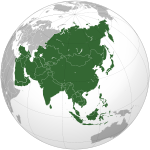
States with limited recognition - Dependencies and
- Special Administrative Regions
AustraliaPeople's Republic of ChinaUnited KingdomCountries and territories of South Asia Countries Sometimes included International membership South Asian Association for Regional Cooperation Agreements South Asian Free Trade AreaMembers Observers Australia · China (PRC) · European Union · Iran · Japan · Mauritius · Myanmar · South Korea · United StatesGuest Coordinates: 26°32′N 86°44′E / 26.533°N 86.733°E
(Rahul kaushik (talk) 16:55, 8 November 2011 (UTC))
Categories:- Nepal
- Federal countries
- Former monarchies of Asia
- Landlocked countries
- Least developed countries
- Member states of the South Asian Association for Regional Cooperation
- Newar
- Republics
- South Asian countries
- States and territories established in 1768
- Member states of the United Nations
- Eastern Region (Purwanchal)
Wikimedia Foundation. 2010.




